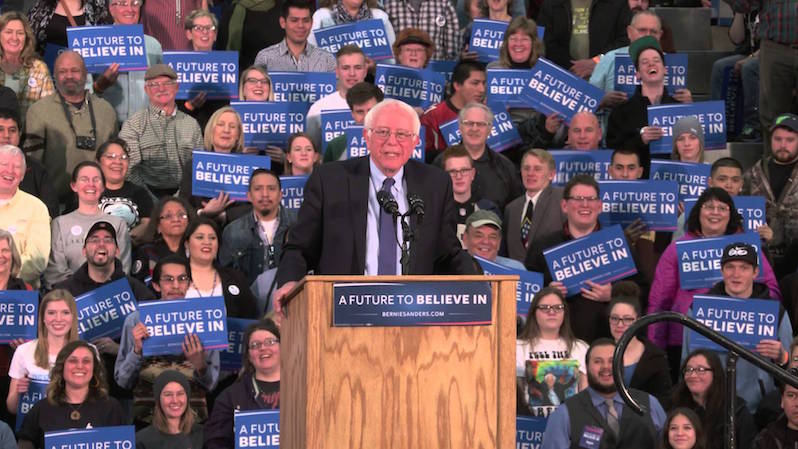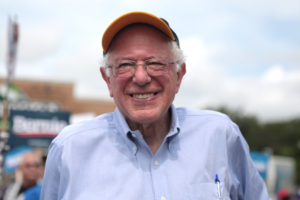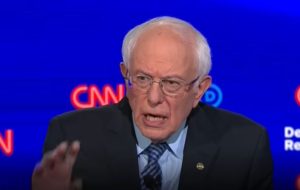Across Los Angeles, Hope Remains for a Big Upset in the California Primary
Their names don’t make headlines in the national media, but the idealists volunteering for the Bernie Sanders campaign are the future of the Democratic Party and of progressives who believe in the electoral process. Bernie Sanders plans to keep fighting for the Democratic nomination until the last vote is counted. (via YouTube)
Bernie Sanders plans to keep fighting for the Democratic nomination until the last vote is counted. (via YouTube)
Bernie Sanders plans to keep fighting for the Democratic nomination until the last vote is counted. (via YouTube)
The day Bernie Sanders upset Hillary Clinton in the Indiana primary, I stopped by his Los Angeles headquarters, a rundown storefront in the Latino neighborhood of East Hollywood, and I talked with campaign volunteers preparing to register voters.
Ismael Parra, one of the volunteers, was hoping for a Sanders win in Indiana that night and, of course, wants one in the California Democratic primary on June 7. Such victories, Parra said, would give the campaign the momentum to stop Hillary Clinton on the first ballot of the Democratic National Convention, throwing it into pandemonium.
“If we get through the first ballot, it will be crazy,” Parra told me on Tuesday.
Parra and I spoke at an important time. The national media is all but awarding the Democratic nomination to Hillary Clinton, and Sanders needs California to stay alive.
Parra, a writer and member of the National Writers Union, is just one in a diverse group of volunteers I’ve met while following the Sanders campaign since early last fall. Their challenge is to propel Sanders to victory in California and win more of the state’s 548 delegates than Clinton does.
Nasim Thompson, a volunteer in another Sanders storefront in a largely African-American neighborhood in South Los Angeles, has the same goal as she canvasses door to door and trains new volunteers.
“We have energized volunteers and community members,” she said.
From the beginning, activists like Parra and Thompson have made the Sanders campaign as much a social and economic movement as a political campaign. Led by its unusual and compelling candidate, the Sanders campaign has given voice to discontent among liberals about the Democratic Party elite. For the two terms of Bill Clinton and two more of Barack Obama, the rich businesspeople and the politicians and technocrats who served them have been the shot callers. They ignored those who felt left out of the ’90s prosperity and the mild recovery from the Great Recession.
Resentment simmered, surfacing only in the Occupy movement and Black Lives Matter, both generally ignored by the mass media. Along came Sanders to give it a voice, a sense of direction and an energy that make Hillary Clinton and her campaign look pallid by comparison. The Sanders team is now the Democratic Party’s activist base, and without its enthusiastic participation, Donald Trump may be elected president in November.
On the afternoon of April 30, I tagged along while Sanders supporters marched through a down-at-the-heels portion of Downtown Los Angeles on their way to a rally at City Hall several blocks away. Drummers in the garb of Aztec Mexico led the march. Organizers were among the crowd, spurring the men and women on. “Are you ready to fight?” a couple of them shouted. I counted about 500 when the march started, but it soon doubled in size, the result, I bet, of days of campaigning on social media. I was impressed with the enthusiasm and organization required to bring out such a crowd.
Organization was also evident the following day at an entirely different venue, the big Beverly Hills home of Lauren Steiner, high above the city in Benedict Canyon. Steiner is a hardworking and effective volunteer leader. Tirelessly pounding away on Facebook, she persuaded about 25 to 30 people to come her house for bagels before they headed to their congressional district caucus to vote for her and others for national convention delegate.
As I watched them sign up for tasks and discuss the campaign, I saw some of the political currents that are shaping the campaign.
One was how to treat Clinton. Some in the room reviled her. A woman objected to what they said. “What I don’t like is the negativity,” a woman said. “We are still Democrats.” A man replied, “I don’t have any loyalty to the party especially when it is headed by crooked Hillary.”
Volunteer Julie Tyler said, “I’ve called people out on Facebook when they talk that way.” And Steiner said, “There is a way of talking about policies that isn’t hateful.” Looking ahead, Steiner and Tyler probably saw the danger, a Trump victory over disunited Democrats.
Steiner brought up a more immediate problem—connecting with the area’s African-American voters and growing Latino population. That’s been a Sanders weakness from the beginning and a possible roadblock to his final, all-out push in California. Clinton is leading Sanders 51 percent to 41.3 percent in the RealClearPolitics average of California polling. She polls well among African-Americans. Latino polling and results from earlier contests are mixed. With the primary election just over a month away, the campaign is setting up low-income outreach teams, but it may be too late.
The future of the Sanders movement—before and after the Democratic National Convention—depends on these disparate volunteers.
If Sanders wins California, it would be a big upset. Yet even if he does, he probably wouldn’t get enough delegates to force the convention into a second ballot and to stop a Clinton nomination. But what happens after the convention is important, too. Will the Sanders movement remain intact? Will Lauren Steiner, Julie Tyler, Nasim Thompson and Ismael Parra get behind Clinton for the fall campaign against Donald Trump?
Their names don’t typically make it into the coverage of the presidential campaign by the national media, but these volunteers are the future of the Democratic Party and of progressives who believe in the electoral process.
If Clinton is to have a chance of defeating Trump, she’ll need them at her side. She’s not going to do it by herself or with her elite backers and veteran political advisers. The Sanders movement is the Democratic Party’s activist base. Without them, Clinton could very well lose.
Lose to Trump? Is that crazy? No.
I wouldn’t put all of my money on Clinton’s plodding, cautious approach to our serious national problems. Nor would I bet on her annoying, condescending smiles when asked questions about tough issues like her Wall Street speaking fees. That won’t work against killer Trump.
After the national convention and the November election, whether Clinton wins or loses, the Sanders volunteers shouldn’t drop out. They’ll have to translate the excitement for the Sanders campaign into enthusiasm for continuing to build a movement: the Sanders revolution. Hopefully, he’ll be leading it, as he promised.
Your support matters…Independent journalism is under threat and overshadowed by heavily funded mainstream media.
You can help level the playing field. Become a member.
Your tax-deductible contribution keeps us digging beneath the headlines to give you thought-provoking, investigative reporting and analysis that unearths what's really happening- without compromise.
Give today to support our courageous, independent journalists.









You need to be a supporter to comment.
There are currently no responses to this article.
Be the first to respond.